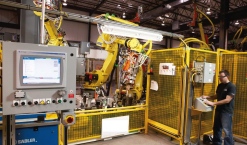
Innovations in Robotics and Evolving Safety Standards Examined in New White Paper
By Canadian Packaging Staff
General Rockwell Automation
Major advances in microprocessor and artificial-intelligence techniques, along with innovations in automation and control systems, are ushering in a new age of robotics, in which once-futuristic visions are becoming realities. Despite these breakthrough applications – in areas ranging from manufacturing to medicine – robots carry risk. Without the proper precautions in place, a robot experiencing a fault or failure might cause serious injuries to people and damage to capital equipment in or around the work cell.
A new white paper, International Safety Standards Keep Pace With Advances in Robotic Technology and Applications, from Rockwell Automation, Inc. examines the major innovations in robotics and robotic systems that new safety standards will address for the first time. The paper focuses on four major new robotic technologies that emerged: cableless teach pendants, human-robot collaboration, robot-to-robot synchronization and vision-based safeguarding systems.
“Robots are among the most critical machines we have in automation today,” says Dan Hornbeck, safety market development manager, Automation and Software Group, Rockwell Automation. “The ability to leverage new safety technology developed in the past few years – including safe speed, safe torque and safe direction – helps us keep workers safer, increase productivity and improve the overall functional safety of an automation system.”
New international robotic safety standards are being drafted by a team of global experts – including representatives of the U.S. Robotic Industries Association (RIA). Once those standards are confirmed, the RIA is expected to update ANSI/RIA R15.06, which was adopted in 1999, to comply with the new International Organization for Standardization criteria for robots and robot systems integration. ISO 10218-1 – the initial updated standard, published in 2006 – specifies requirements and provides guidance for the assurance of safety in design and construction of the robot itself, not the entire robot system. Part 2 – or ISO 10218-2, which is undergoing development and is expected to be published in 2010 – covers the integration and installation of a robot system or cell, thereby providing a more comprehensive set of requirements for robot safety.
By establishing guidelines to govern the safe use of these innovations in robotics, the ISO standard will open the door for these applications around the world.
Advertisement

